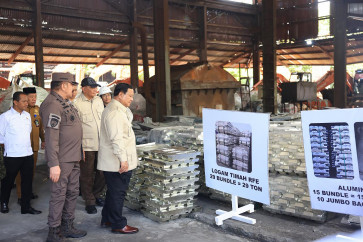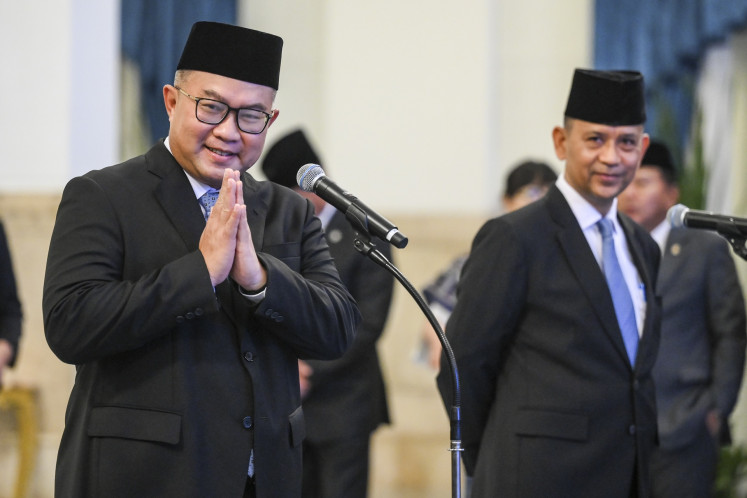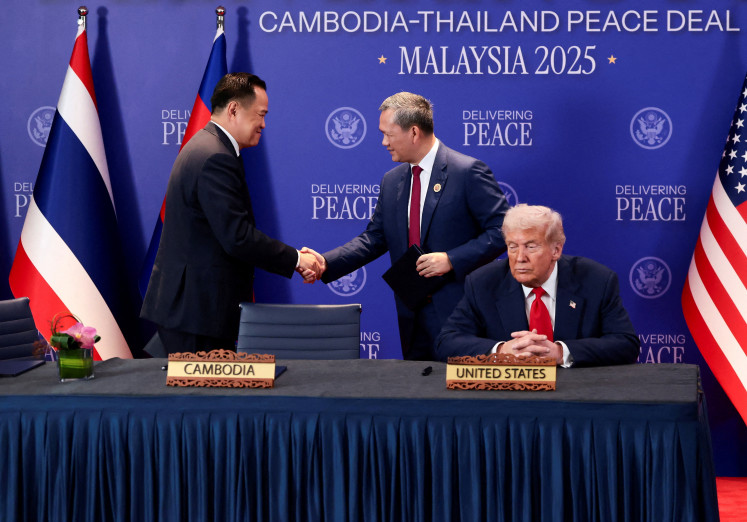Popular Reads
Top Results
Can't find what you're looking for?
View all search resultsPopular Reads
Top Results
Can't find what you're looking for?
View all search resultsChinese-Indonesians dig into their past in the Netherlands
Queen of the court: Hilly Tjioe (right), winner of five national titles during the Indonesian Open Tennis Championships, after triumphing in the competition in Semarang, West Java, in 1957
Change text size
Gift Premium Articles
to Anyone
 Queen of the court: Hilly Tjioe (right), winner of five national titles during the Indonesian Open Tennis Championships, after triumphing in the competition in Semarang, West Java, in 1957. (CIHC/J. De Moel-Nitisusanta)" border="0" height="310" width="500">Queen of the court: Hilly Tjioe (right), winner of five national titles during the Indonesian Open Tennis Championships, after triumphing in the competition in Semarang, West Java, in 1957. (CIHC/J. De Moel-Nitisusanta)
Queen of the court: Hilly Tjioe (right), winner of five national titles during the Indonesian Open Tennis Championships, after triumphing in the competition in Semarang, West Java, in 1957. (CIHC/J. De Moel-Nitisusanta)" border="0" height="310" width="500">Queen of the court: Hilly Tjioe (right), winner of five national titles during the Indonesian Open Tennis Championships, after triumphing in the competition in Semarang, West Java, in 1957. (CIHC/J. De Moel-Nitisusanta)A tennis superstar from the 1950s. A Yogyakarta cooking class in the 1930s. Penny romances from the turn of the 20th century. What is the common denominator among the three?
Itâs all part of the history shared by Chinese-Indonesians who left the country to live in the Netherlands.
The Chinese-Indonesian Heritage Center (CIHC) in Leiden is working so that these historical gems are not forgotten over time.
Tens of thousands of Chinese-Indonesians and their descendants have lived in the Netherlands for almost a century.
However, academic Patricia Tjiook-Liem said that she was taken aback a few years ago when she realized that no substantial historical material could be found about the community.
âI had gone to seminars discussing migrant groups in the Netherlands, like the Indos, Moluccans, Surinamese and even Chinese people from China. But nothing on the Chinese-Indonesians,â said Tjiook-Liem, who was born in Cirebon, West Java, in 1939 and has lived in the Netherlands since she was 17.
 Lady lawyer: An undated photo of Desiree Tan, the first Chinese-Indonesian woman (and possibly the first woman) to graduate from what is now the law school of the University of Indonesia. (CIHC/S.Y. Kan)
Lady lawyer: An undated photo of Desiree Tan, the first Chinese-Indonesian woman (and possibly the first woman) to graduate from what is now the law school of the University of Indonesia. (CIHC/S.Y. Kan)
Tjiook-Liem joined forces with Indonesia specialist Henk Schulte Nordholt, head of research at the Royal Netherlands Institute of Southeast Asian and Caribbean Studies (KITLV) in Leiden to form the CIHC.
Nordholt said that the Chinese-Indonesians in the Netherlands had been âmodest and reservedâ.
âThe Chinese-Indonesians here tend to keep to themselves and solve their own problems,â added Tjiook-Liem, who did completed her dissertation on the legal status of the Chinese in the Netherlands East Indies.
The way they lived in Europe was not too different from their way of life in Indonesia, she says. Whether under Dutch colonial rule or Indonesia, they were a minority group that worked hard kept a low profile.
Most who emigrated to The Netherlands quickly integrated into Dutch society, which Tjiook-Liem attributed to a relatively high level of education and Dutch fluency.
However, the downside was that the Chinese-Indonesians remained relatively invisible. âMany of these emigrants are at an advanced age. If their stories go untold, part of Indonesian history will disappear with them,â Tjiook-Liem said.
The migration of Chinese-Indonesians to The Netherlands reflected social and political conditions here, Tjiook-Liem said, dividing migration into three periods.
First are those who came to further their studies prior to World War II. âThe earliest Chinese-Indonesian student recorded here was studying law in 1886.â
Next are those who left their birth country due political unrest during the independence struggle between 1945 and 1949 followed by those who came after 1959, when political conflicts began to heat up, and after the attempted coup in 1965, blamed on the Indonesian Communist Party (PKI), which had friendly ties with China.
âThe Netherlands was not the only destination for those leaving Indonesia during this time,â Tjiook-Liem said. âSome also went to countries like the US and Australia, and even China. However, the Netherlands remained a plausible alternative as many of the migrants spoke Dutch, or had relatives who already lived here.â
Nordholt said that the Chinese-Indonesians carried a wealth of historical information that needed to be explored.
Unlike previous Indonesian historians, who viewed colonial history with emotion, younger scholars can scrutinize the time more objectively, he says. âColonial history is part of Indonesian history, as is the history of the different ethnic groups in the country.â
He continues. âHistory with a capital âHâ has already been established. Now is the time to look at social history, and CIHC is trying to do just that
span class="caption" style="width: 498px;">Queen of the court: Hilly Tjioe (right), winner of five national titles during the Indonesian Open Tennis Championships, after triumphing in the competition in Semarang, West Java, in 1957. (CIHC/J. De Moel-Nitisusanta) A tennis superstar from the 1950s. A Yogyakarta cooking class in the 1930s. Penny romances from the turn of the 20th century. What is the common denominator among the three? Lady lawyer: An undated photo of Desiree Tan, the first Chinese-Indonesian woman (and possibly the first woman) to graduate from what is now the law school of the University of Indonesia. (CIHC/S.Y. Kan) Out of the kitchen: A cooking class for Chinese-Indonesian ladies from the Tiong Hwa Hoe Lie Hwee in Yogyakarta in 1932. The group was very active in building the community, holding 'fancy fairs' and Shanghai dress shows. The writing on the blackboard reads in part: 'Wij doen niet onder voor de mannen'. We are not inferior to men. (CIHC/Liem Hoo Soei)
Q
It's all part of the history shared by Chinese-Indonesians who left the country to live in the Netherlands.
The Chinese-Indonesian Heritage Center (CIHC) in Leiden is working so that these historical gems are not forgotten over time.
Tens of thousands of Chinese-Indonesians and their descendants have lived in the Netherlands for almost a century.
However, academic Patricia Tjiook-Liem said that she was taken aback a few years ago when she realized that no substantial historical material could be found about the community.
'I had gone to seminars discussing migrant groups in the Netherlands, like the Indos, Moluccans, Surinamese and even Chinese people from China. But nothing on the Chinese-Indonesians,' said Tjiook-Liem, who was born in Cirebon, West Java, in 1939 and has lived in the Netherlands since she was 17.
Tjiook-Liem joined forces with Indonesia specialist Henk Schulte Nordholt, head of research at the Royal Netherlands Institute of Southeast Asian and Caribbean Studies (KITLV) in Leiden to form the CIHC.
Nordholt said that the Chinese-Indonesians in the Netherlands had been 'modest and reserved'.
'The Chinese-Indonesians here tend to keep to themselves and solve their own problems,' added Tjiook-Liem, who did completed her dissertation on the legal status of the Chinese in the Netherlands East Indies.
The way they lived in Europe was not too different from their way of life in Indonesia, she says. Whether under Dutch colonial rule or Indonesia, they were a minority group that worked hard kept a low profile.
Most who emigrated to The Netherlands quickly integrated into Dutch society, which Tjiook-Liem attributed to a relatively high level of education and Dutch fluency.
However, the downside was that the Chinese-Indonesians remained relatively invisible. 'Many of these emigrants are at an advanced age. If their stories go untold, part of Indonesian history will disappear with them,' Tjiook-Liem said.
The migration of Chinese-Indonesians to The Netherlands reflected social and political conditions here, Tjiook-Liem said, dividing migration into three periods.
First are those who came to further their studies prior to World War II. 'The earliest Chinese-Indonesian student recorded here was studying law in 1886.'
Next are those who left their birth country due political unrest during the independence struggle between 1945 and 1949 followed by those who came after 1959, when political conflicts began to heat up, and after the attempted coup in 1965, blamed on the Indonesian Communist Party (PKI), which had friendly ties with China.
'The Netherlands was not the only destination for those leaving Indonesia during this time,' Tjiook-Liem said. 'Some also went to countries like the US and Australia, and even China. However, the Netherlands remained a plausible alternative as many of the migrants spoke Dutch, or had relatives who already lived here.'
Nordholt said that the Chinese-Indonesians carried a wealth of historical information that needed to be explored.
Unlike previous Indonesian historians, who viewed colonial history with emotion, younger scholars can scrutinize the time more objectively, he says. 'Colonial history is part of Indonesian history, as is the history of the different ethnic groups in the country.'
He continues. 'History with a capital 'H' has already been established. Now is the time to look at social history, and CIHC is trying to do just that
This group's contribution to Indonesian history and culture has been greatly underestimated, according to Nordholt. 'The Chinese played an important role in developing urban culture in Indonesia. They were active in film, photography and publishing. Penny romances, written early last century in Malay, had a big impact in the dissemination of the language.'
Tjiook-Liem and Nordholt said that they had been surprised by the overwhelming response from hundreds of members of the Chinese-Indonesian community during the center's launch in 2012.
Since then, Tjiook-Liem says that the talks she has held about the CIHC in academia and public forums 'have consistently been met with enthusiasm'.
The CIHC aims to gather and preserve as much material and stories that might otherwise only be available within individual families, or would eventually be lost altogether.
'We want to make people aware that objects like old diplomas, photographs, newspaper clips, scrapbooks or home movies are valuable historical artifacts,' says Jan van Rosmalen, coordinator of KITLV's Special Collections. 'When individuals leave these objects for us to store, they are preserved for their family's future generations, and can also be used for academic research.'
CIHC's material has become part of the KITLV archives, home of the world's largest collection of printed material coming from Indonesia. 'Aside from magazines, books and posters, we also have an extended collection of Indonesian music and films.'
The center is also looking for people to come forward and tell their stories, both in writing and otherwise. 'We want oral history to form an important part of CIHC,' Tjiook-Liem says.
Last year, CIHC started an oral history project, interviewing elderly Chinese-Indonesian migrants.
It is not always easy, as the target population is mostly 80 years of age or older and about 10 people have participated. She explains: 'The interviewees should be open to tell their life story, and have their memory still intact.'
There is a lot on CIHC's plate this year. Tjiook-Liem explains that late last year, a number of Chinese-Indonesians in the Netherlands established a foundation to raise funds for the CIHC.
Nordholt and Tjiook-Liem hope that the material gathered by CIHC will become a catalyst for greater interest and research into the Chinese-Indonesian migrants.
'Without our recorded history,' Tjiook-Liem says, 'we don't really exist.'
For more information, visit cihc.nl.
Your Opinion Matters
Share your experiences, suggestions, and any issues you've encountered on The Jakarta Post. We're here to listen.
Thank You
Thank you for sharing your thoughts. We appreciate your feedback.
Share options
Quickly share this news with your network—keep everyone informed with just a single click!
Gift Premium Articles
to Anyone
Share the best of The Jakarta Post with friends, family, or colleagues. As a subscriber, you can gift 3 to 5 articles each month that anyone can read—no subscription needed!
Continue in the app
Get the best experience—faster access, exclusive features, and a seamless way to stay updated.










